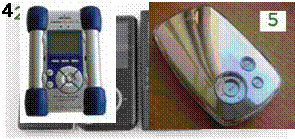Designers can frequently increase the durability of the solutions they create by designing in classic styles, rather than trendy ones. These design styles include decisions of form, color, typeface, texture, material, and so on. Typically, design that adheres to classic tastes will meet more people’s needs for a longer period of time, although it is at odds with the trendy and faddy nature of much of the design industry and media. Consider the first iPods (now called the iPod Classic). When these first appeared, the media called them a beautiful design, but most designers looked at them and asked “where’s the design?” To graphic and industrial designers alike, they could hardly be less designed: a white rectangle with rounded corners, no ornamentation, no color, white circular controls, and a rectangular
 |
 |
screen. Compare these to the many MP3 players of the time from Rio, Samsung, Sony, and so on that came in all manner of shapes, colors, and materials (see Figure 10.3). Now look at the marketplace: few of these MP3 players remain viable (and customers aren’t clamoring for other shapes and styles, though color choice is still desired), and most competitors have moved to more classic solutions.
1: http://www. flickr. com/photos/rosenfeldmedia/3265606966
: http://www. flickr. com/photos/rosenfeldmedia/3264742031
: http://www. flickr. com/photos/rosenfeldmedia/3264784065
4: http://www. flickr. com/photos/rosenfeldmedia/3264754313
: http://www. flickr. com/photos/rosenfeldmedia/3264793861
FIGURE 10.3
MP3 players take a myriad of different forms but many seem faddish and destined for fast retirement.



